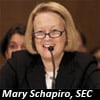The robustness of US equity markets has again been called into question following the systems glitch that almost wiped out market maker Knight Capital, but more rules to control electronic trading may not be the answer.
On 1 August, Knight Capital suffered a technology error that caused it to send duplicate orders to NYSE Euronext’s New York Stock Exchange just after the opening bell. The number of orders sent to the exchange by Knight during the incident was around 300 million, almost triple the norm. NYSE Euronext informed Knight of the error soon after it occurred but it reportedly took Knight up to 40 minutes to rectify the problem.
Knight lost US$440 million from the glitch and came close to extinction before the broker completed a refinancing agreement with a consortium of new investors including GETCO, VanGuard and Jefferies on 6 August.
In response to the latest in a spate of US stock trading technology failures, the Securities and Exchange Commission (SEC) has scheduled a roundtable for 14 September that will focus on the design and control of all automated market systems.
 “Reliance on
technology has enabled the markets to achieve extraordinary levels of speed and
efficiency,” said SEC chairman Mary Schapiro. “But with technology comes a
responsibility for getting it right, minimising errors and protecting the
interests of investors.”
“Reliance on
technology has enabled the markets to achieve extraordinary levels of speed and
efficiency,” said SEC chairman Mary Schapiro. “But with technology comes a
responsibility for getting it right, minimising errors and protecting the
interests of investors.”
Schapiro has also asked staff to accelerate the proposal of a rule that requires exchanges and market centres to have specific procedures in place to ensure the stability of their systems.
Knight is a designated market maker for around 600 NYSE-listed stocks and generates significant revenues from placing orders on behalf of retail brokers.
Hold fire
Rather than triggering a raft of new rules, market participants believe the Knight incident should raise questions on whether existing mechanisms are working effectively.
After the flash crash on 6 May, when a rogue algo trade sent US markets sharply lower in the space of 20 minutes before rebounding in a similar period, the SEC introduced a number of measures designed to bolster market stability and investor confidence. These included single-stock circuit breakers, which from next year will be adjusted to a limit up-limit down mechanism, a new rule that requires brokers and their clients to have sufficient pre-trade checks in place before accessing markets, and most recently a consolidated audit trail that allows regulators to monitor fragmented equity trading activity more effectively.
“Part of the Knight incident happened during the first 15 minutes of trading when the circuit breakers don't apply, which is something the SEC may want to revisit,” said Justin Schack, head of the market structure analysis group at boutique brokerage and NYSE member firm Rosenblatt Securities.
Others have suggested that the Knight scenario was exactly the type of problem that the pre-trade access rule was meant to prevent.
 “Why didn’t the risk control component of
the market access rule that is supposed to prevent duplicative trading or
trading beyond credit limits kick in,” said Jamie Selway, head of liquidity
management at agency broker ITG. “It could be the case that Knight misapplied
market access standards, so this is more of a regulatory compliance question,
rather than a technology question.”
“Why didn’t the risk control component of
the market access rule that is supposed to prevent duplicative trading or
trading beyond credit limits kick in,” said Jamie Selway, head of liquidity
management at agency broker ITG. “It could be the case that Knight misapplied
market access standards, so this is more of a regulatory compliance question,
rather than a technology question.”
There is also a case for allowing more leeway in the policy on clearly erroneous trades adopted by the SEC after the flash crash. The current rules meant only orders in six symbols affected by the Knight incident qualified for cancellation as these were executed 30% or more from the reference price. Greater flexibility by the SEC when determining erroneous trades could have eased Knight’s losses.
But one area the SEC may want to consider new rules for is testing of new systems and software. Knight has said the problem derived from an installation of software, while the debut listing on BATS Exchange of its parent company BATS Global Markets also succumbed to a technology failure that forced the IPO to be aborted. Nasdaq OMX has also come under fire after it was beset by an error that delayed the start of trading in Facebook stock.
In the wake of the problems suffered by Knight, the Futures Industry Association’s Proprietary Trading Group, a lobby group for high-frequency trading firms, will revise industry guidelines released earlier this year that recommend a series of controls and tests prior to the installation of new systems.
Nonetheless, there are those that believe no amount of regulation can predict and prevent future technology failings, suggesting instead more meaningful interaction between players and watchdogs.
“As long as people keep trying to develop and evolve technology, there will be failures,” said Allen Zaydlin, CEO of Inforeach, a provider of electronic trading solutions. “The bigger problem is the calibration between the SEC and the rest of the market.
“For example, the consultation periods held before new regulation comes into force make little difference to the final shape of regulation. Participants have no idea whether their contributions, opinions and facts are considered. There should be a committee that analyses these market feedback and responds with empirical scientific evidence.”
Falling prices not failing systems
While the technology issues that continue to dog US markets are regarded by many as the primary factor in damaging investor confidence, Schack points out that the overall performance of equities is in fact a bigger issue. According to figures from Strategic Insight, an Asset International-owned fund data analysis company, only US$91 billion was invested in US equity funds between 2008 and 2011. Between 2003-2007, the minimum yearly investment into US equity funds was US$205 billion. Returns on the S&P 500 index have been equally rocky over the last decade reaching highs of 28.7% in 2003, and lows of -37.2% in 2008.
“In the last decade, equity investors have suffered a series of boom-bust cycles that has cost them tons of money, beginning with the dot-com bubble and continuing through the wave of corporate frauds like Worldcom and Enron, the worst financial crisis in most people’s lifetimes, the European debt crisis and the US debt ceiling debacle,” said Schack. “Any lack of investor confidence has a lot more to do with those factors than the technical glitches we’ve seen.”
